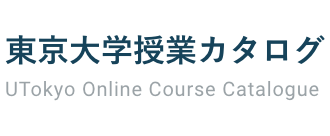過去(2024年度)の授業の情報です
学内のオンライン授業の情報漏洩防止のため,URLやアカウント、教室の記載は削除しております。
最終更新日:2025年10月17日
授業計画や教室は変更となる可能性があるため、必ずUTASで最新の情報を確認して下さい。
UTASにアクセスできない方は、担当教員または部局教務へお問い合わせ下さい。
最終更新日:2025年10月17日
授業計画や教室は変更となる可能性があるため、必ずUTASで最新の情報を確認して下さい。
UTASにアクセスできない方は、担当教員または部局教務へお問い合わせ下さい。
Culture and Catastrophe: Japanese Culture Responding to Disaster
The course looks at the representations of disaster in various media such as literature, theatre, film, or manga. It explores the role of the arts for investigating the human experience of calamities including the Fukushima triple disaster and the nuclear bombings of Hiroshima and Nagasaki. Scrutinizing these tragic occurrences, the course will question, for example, how artists participate in shaping perceptions about natural and man-made disaster, how memory is re-shaped in cultural production, or discuss the sociopolitical potentials of art works. The readings will introduce students to theories and methods of analyzing artistic discourse and help them to situate their findings into the wider context of Japanese society and culture.
時間割/共通科目コード
コース名
教員
学期
時限
21245005
GHS-CR6E01L1
Culture and Catastrophe: Japanese Culture Responding to Disaster
GEILHORN Barbara
水曜2限
講義使用言語
英語
単位
2
実務経験のある教員による授業科目
NO
他学部履修
可
開講所属
人文社会系研究科
授業計画
Preliminary schedule
09.10.2024Introduction to the topics of the seminar
16.10.2024Theoretical Introduction
23.10.2024Background: The atomic bombings of Hiroshima and Nagasaki
30.10.2024Atomic Bomb Literature
06.11.2024The Atomic Bombings in Film
20.11.2024Nuclear catastrophes in Popular Culture
04.12.2024Background: The Fukushima triple disaster “
11.12.2024Fukushima” in Popular Culture
18.12.2024The Fukushima triple disaster in Literature
08.01.2025The Fukushima triple disaster in Theatre
15.01.2025“Fukushima” in Film
授業の方法
discussion, presentations, media
成績評価方法
•Class presentation. 20%
A class presentation of no more than 20 mins that responds to the themes and readings for that work. The presentation should use PowerPoint or similar presentational media.
•An essay of approx. 10 pages on a topic covered in the course. 65%
Students are free to develop their own essay topic based on the course content in discussion with the professor. All essay topics should be approved by the professor before starting work. Due dates of essays will be discussed in the beginning of the semester. My preference is for your essay to be submitted as a word document.
•Active participation and attendance. 15%
Each week there will be a discussion about the topic, readings and or performance that you have read and viewed. What questions arise from the readings – what do you find interesting and what don’t you yet understand properly?
教科書
none
参考書
Preliminary reading
Flores, Linda and Geilhorn, Barbara (eds): Literature After Fukushima From Marginalized Voices to Nuclear Futurity. Routledge, 2023.
Geilhorn, Barbara and Kristina Iwata-Weickgenannt (eds): ‘Fukushima’ and the Arts – Negotiating Nuclear Disaster. Routledge, 2016.
Kingston, Jeff. “Mismanaging Risk and the Fukushima Nuclear Crisis,” The Asia-Pacific Journal 10.12.4, Mar. 19, 2012. http://www.japanfocus.org/*****
Kingston, Jeff. “Japan's Nuclear Village,” The Asia-Pacific Journal, Vol. 10, Issue 37, No. 1, September 10, 2012. http://www.japanfocus.org/*****
Starrs, Roy (ed.): When the Tsunami Came to Shore. Culture and Disaster in Japan. Leiden: Global Oriental, 2014.
履修上の注意
Active participation, attendance and preparation of readings are expected.





 大学院
大学院

 マイリストに追加
マイリストに追加
 マイリストから削除
マイリストから削除


